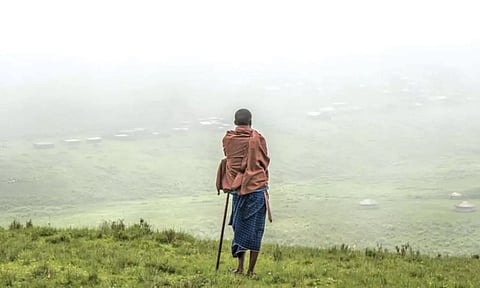

NEW YORK: Over 600,000 tourists travel to Tanzania’s Ngorongoro Conservation Area each year, and many will catch a glimpse of the Great Migration: the famed trek of more than one million wildebeests and thousands of zebras, gazelles and other animals crossing over the Mara River into Kenya and back. Yet the Tanzanian government believes it can attract many more tourists seeking the safari adventure of a lifetime: five million by 2025, bringing $6 billion with them per year, according to a recent plan.
That’s why government officials recently announced a change in the legal status of Ngorongoro that will prohibit human settlement inside and near it. The decision will force authorities to remove nearly 100,000 people — mostly Maasai pastoralists who have used Ngorongoro’s vast grasslands to sustain their seminomadic cattle-herding way of life for generations — from the protected area. According to the government, the Maasai must be removed to conserve the land and protect biodiversity. The Maasai argue that removal puts their lives and cultural survival at risk and that the government should instead expand tourism in a way that respects their rights.
As countries around the world pursue environmental goals like preserving 30 percent of the planet’s land and seas by 2030 — goals that can also yield opportunities for eco-tourism development and carbon credit sales — they’re converting lands rich in natural beauty and biodiversity into protected areas. Often they do so with financing and guidance from the biggest conservation organisations, such as the World Wildlife Fund and Wildlife Conservation Society, and wealthy countries like the United States, France, Germany and Japan.
Yet in many cases people are already living and surviving off these lands — indeed, an estimated 476 million Indigenous peoples dwell on lands that are home to 80 percent of the world’s biodiversity. When governments decide that nature conservation and potential revenue from it take priority over existing human activities, too often they resort to evictions, destruction of agricultural fields and confiscation of livestock, sometimes through stupefying violence, to get residents off the land. At the University of Arizona Indigenous peoples law and policy program, which hosts the United Nations Special Rapporteur on the Rights of Indigenous Peoples, reports of these kinds of human rights abuses and complaints linked to conservation stream in on a weekly, and sometimes even daily, basis from all corners of the globe.
In India, the creation of tiger reserves to attract foreign tourist dollars has resulted in violent clashes and the evictions of scores of Adivasi Indigenous peoples from their ancestral lands. In the Democratic Republic of Congo, the Batwa Indigenous peoples (formerly referred to by the derisive, racist term “pygmies”) continue to resist government efforts to block them from returning to the Kahuzi-Biega National Park after being evicted in the 1970s. Just last month, Park Authority guards, accompanied by Congolese military, reportedly raided Batwa villages and burned their homes to the ground, accusing the Batwa of being members of a Tutsi insurgent group. (The Batwa reject the accusation.)
Countries frequently regard these abuses as legally defensible because, unlike in the United States and most other Western nations with significant tribal populations, many African, Asian and Latin American Indigenous peoples have not been granted secure tenure and rights in their traditionally occupied lands. But the wildlife officials and others initiating and supporting large-scale relocation of Indigenous communities are too often ignoring another, far better way to protect biodiversity that doesn’t require destroying lives and livelihoods in the process. Community-based models of conservation, particularly Indigenous-led conservation practices, have proved time and again to protect biodiversity effectively. Research and case studies from the ground show that these practices work just as well as, and in many instances even better than, the methods that exclude them.
Take the Bears Ears National Monument in Utah, which is now co-managed by five Native American tribes. In Australia, the Indigenous Gunditjmara people harvest eel and help manage the Budj Bim Cultural Landscape within their traditional homelands. Other projects in Mexico, New Zealand and Canada show it’s possible to meet climate and biodiversity goals while respecting the human rights and knowledge of Indigenous people living in protected areas.
The State Department and other U.S. agencies can help protect the property rights of Indigenous people in their traditional lands by pressuring countries to recognise those rights. Using credible information, they can increase monitoring and withhold funding from countries and projects where such abuses take place. Likewise, while the World Wildlife Fund and the Wildlife Conservation Society say they are using a human-rights-based approach to conservation, no group should be spending millions of dollars to provide support for projects in protected areas where Indigenous peoples’ property and other rights are infringed. Instead, they can use their considerable leverage and influence in places where abuses are still being perpetrated to ensure these rights are respected. For instance, they could demand at the outset of a project that they won’t move forward until there is certainty on Indigenous people’s legal rights through the local legal system.
In all instances, Indigenous peoples’ right to free, prior and informed consent must be guaranteed in any protected area project that will have an impact on their traditional lands, lives or livelihoods. Otherwise, the world’s urgently needed conservation and climate reduction goals will have, in effect, been purchased at the expense of the world’s Indigenous peoples. It is these communities that possess some of the most valuable knowledge and methods, tested over time and generations, needed to solve a global climate and biodiversity crisis not of their own making.
Robert Williams is a law professor and the faculty chair of the Indigenous peoples law and policy program at the University of Arizona